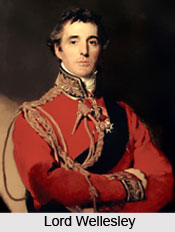 Indian State Forces, until the year 1947, formed an important adjunct of the defence forces in India. They originated with the implementation of the Subsidiary Alliances by Lord Wellesley. As in some cases the States were unable to ensure regular finances for these forces, large tracts of land were ceded for maintenance. In most of the cases the revenues of these lands far exceeded the actual requirements. The Indian State Forces were employed outside the respective states also. Officers in these armies were paid very liberal allowances. This salary of commandant of the Hyderabad Contingent far exceeded even the pay of the Commander-in-Chief in India.
Indian State Forces, until the year 1947, formed an important adjunct of the defence forces in India. They originated with the implementation of the Subsidiary Alliances by Lord Wellesley. As in some cases the States were unable to ensure regular finances for these forces, large tracts of land were ceded for maintenance. In most of the cases the revenues of these lands far exceeded the actual requirements. The Indian State Forces were employed outside the respective states also. Officers in these armies were paid very liberal allowances. This salary of commandant of the Hyderabad Contingent far exceeded even the pay of the Commander-in-Chief in India.
As more demands were placed on these forces their organisation and training was brought on the same lines as the regular Indian Army. Later they were termed as the Imperial Service Troops. To ensure a uniform standard the Commander-in-Chief exercised a general supervision and control over these forces. For this purpose nucleus staffs were appointed under the Military Adviser in Chief. Each state was provided with a Military Adviser and Assistant Military Adviser.
Before the 1914-18 War near about 29 states maintained these forces. By 1914 these numbered about 22,500. They were further re-organised after the War and classified into three categories. Class `A` troops were organised on the lines of the Indian army with similar establishment, weapons and equipment. Class `B` troops were a little inferior to Class `A`. Class `C` was all militia battalions which were not permanently embodied. Their organisation and standard of training was inferior to Class B troops. In the year 1923 the Indian State Forces consisted of about 27,000 men. During the 1939-45 War also these forces fought side by side with the Indian army units in many a campaign and theatre and distinguished themselves very well. With the attainment of independence the maintenance of such forces became an anomaly and they were slowly absorbed in the present army as far as possible.
Travancore State Forces have a long and glorious past. In the year 1934, when the State joined the Indian State Forces Scheme, the Nayar Brigade was merged with the Travancore State Forces and trained under selected Indian Officers. On merger of the state with the Indian Union, the 1st Battalion was amalgamated with The Madras Regiment as its 9th Battalion and the 2nd as the 16th Battalion. Cochin State Forces is also known for its glorious history. In 1934, on the State joining the State Forces Scheme, it was re-designated as 1st Cochin Infantry, eventually becoming the 17th (Cochin) Battalion. The credit for the organisation and equipping of Mysore`s forces is attributed to Hyder Ali. After the fall of Tipu Sultan, most of his forces were disbanded. A few retained components along with the infantry were re-organised and were eventually called the Mysore Infantry.






